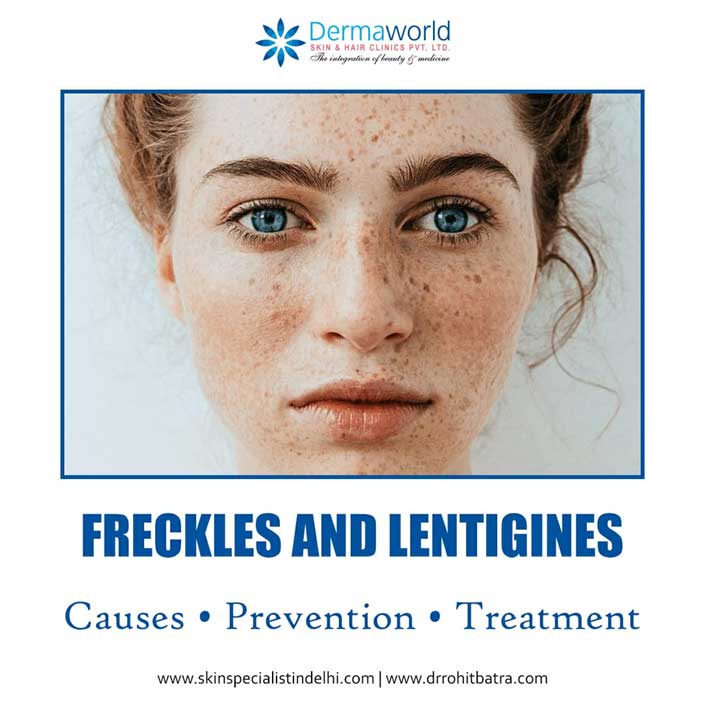Lentigo & Freckles Removal Treatment in Delhi

Get the best & quality Freckles treatment in Delhi at best cost by Dr. Rohit Batra. Continue to read about the causes, prevention & the treatment options for Freckles & Lentigo
Freckles are one of the most frequently identified pigmented lesions seen on skin which tend to occur in light-skinned individuals with red or blonde hair and are often in sun-exposed areas such as the face, upper trunk, and the posterior aspect of the arms and hands.
Freckles are benign skin lesions that are usually round in shape, light to dark brown in color, and are just a few millimeters in diameter.
Early in life, they can increase in number and distribution, but they often decrease in number as a person reaches adulthood.
Lentigo (plural lentigines) is a discrete hyperpigmented macule that is mostly benign. Two main types of lentigines are:
- Simple lentigo
- Solar lentigo
The color of lentigines does not change in response to sunlight.
Solar lentigines, also called sun spots, liver spots, age spots, or actinic lentigines, are well circumscribed, round to irregularly shaped macules with varying colors ranging from light brown to black.
These occur in response to chronic photodamage and are therefore most commonly seen in the elderly. Solar lentigines are mainly seen in people with lighter skin.
Causes
Freckles are thought to be directly influenced by exposure to sunlight, and thus, less ultraviolet (UV) exposure such as during winter months will result in lightening of the freckles.
Freckles occur as a result of increased melanin content inside of keratinocytes, mainly seen in the basal cell layer. The number of melanocytes is normal.
Lentigines are the result of increased melanocytes in the basal layer of the skin and sometimes increased melanin content in the upper layers of the skin.
Genetics- An autosomal dominant pattern of inheritance has been suggested in the literature for freckles.
Solar lentigines are thought to be more acquired, and along with simple lentigines, the genetic associations related to these diagnoses are not clearly defined in the literature.
Prevention
The best way to prevent both freckles and solar lentigines is sun avoidance. Sun protection will help to lighten lesions and is important because these patients are at a higher risk for skin cancer.
A broad-spectrum sunscreen should be reapplied every 1.5-2 hours when in sunlight. Sun-protective clothing such as wide-brimmed hats and sun shirts are also be recommended.
Treatment
Topical
Post Prescription Cream
It lightens the skin and fades the dark spots by helping to match the normal skin tone. But it provides slow results. Hence, advanced dermatological treatments are often recommended along with topical creams to achieve a brighter, lighter and improved pigmentation free skin. Few examples are:
- Topical retinoids (tretinoin 0.025%- 0.1% cream nightly)
- Bleaching agents (hydroquinone- 2% or 4% twice daily)
Procedures
- Lasers (Q switched Alexandrite and Nd:Yag)
- Superficial chemical peels
- Intense pulsed Light (IPL)
- Microdermabrasion
- Laser treatment
To reduce hyperpigmentation, laser treatment works best to remove dark pigmented spots by using targeted light beams. Two main types of lasers are:
- Ablative
- Non-ablative
Ablative lasers use intense light beams to remove layers of the skin. Ablative lasers are suitable for people with fair skin.
Non-ablative lasers aim the dermis to cause collagen growth and improve skin elasticity. Both ablative and non-ablative laser breaks elements or pigments in the skin to cause regeneration of the new skin cells and give more tightened and toned skin.
The effective laser treatment removes pigmentation without scarring.
Laser Toning method is the most effective laser treatment for hyperpigmentation. The procedure involves using a Q Switched laser that reduces the melanin production from different layers of the skin, and helps to correct irregularities of pigment in the skin.
People with age spots, uneven toned skin, tanned skin, sunspots, and open pores are suitable candidates for this procedure.
Chemical peel
In this method, a chemical peel solution is applied which gently removes the topmost layer of the skin and helps improve cellular renewal and regeneration. Dead skin cells are then removed off, and healthier cells restore the natural glow of the skin and provide a refreshed and brighter look.
Intense Pulsed light (Photo Facials)
It is a non-invasive procedure which uses a wide spectrum of light to penetrate the skin and targets excess melanin pigment present in the skin. Further, the body’s immune system removes those breakdown particles.
This treatment effectively treats skin issues such as brown spots, redness, and sunspots.
Microdermabrasion
During this procedure, dead and damaged skin cells are exfoliated, and the uppermost damaged layer of the skin is removed safely to reveal healthy skin.


